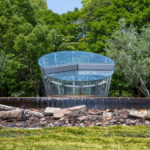Column 5 Toward the 100th Anniversary of the Atomic Bombings
Tomoko Watanabe
When green is lost, peace will be lost; and when green is revived, peace will be restored. There are 160 “A-bombed trees (hibaku-jumoku)” in Hiroshima, which are not well known even to Hiroshima’s own citizens. These Abombed trees are storytellers of the catastrophe of the atomic bomb. In particular, a number of survivor trees with one trunk, still standing in their original locations, lean toward the hypocenter, as if showing the direction to ground zero. Voicelessly, this Abombed tree speaks to us human beings about that day and moment which should never be forgotten. The City of Hiroshima, 75 years after the calamity, has revived itself as a beautiful city rich in water and greenery, and continues to transform itself toward further development. However, during that process, A-bombed trees are gradually being forgotten, and A-bombed buildings are being lost year after year. In 2045, a hundred years after the atomic bombing, what will the City of Hiroshima be like? I believe that the spirits of people who lived their life there reside in the city. Just like the Abombed trees that survived, many of those who survived the catastrophe of the atomic bombing gave birth and raised new generations, enduring hardship as they worked to reconstruct their city. Furthermore, these people have been appealing for the abolition of nuclear weapons, bearing themselves up from tragedy with the conviction that “the same suffering must never be brought anywhere in the world.” Today, owing to their efforts, Hiroshima has become a special place of pilgrimage for people across the world who long for peace and justice. I hope, from the bottom of my heart, that Hiroshima will inherit and honor the spirits of the A-bomb survivors at any cost, and be a city which strives for “a world without nuclear weapons” together with those who share the same will, using the Nuclear Ban Treaty as leverage.
I wonder, by 2045, how we can make the majority of countries in the world— including Japan and those nations that possess nuclear weapons—ratify the Nuclear Ban Treaty and firmly establish in public opinion ideals such as “we don’t need nuclear weapons,” and “we don’t support national security policies relying on nuclear deterrence” among a preponderance of people across the world. What can Hiroshima do to that end?
First and foremost, we must continue to spread the word about the inhumanity of nuclear weapons, and communicate the tragic realities of the atomic bombings to future generations and beyond borders. To hand down the memory of the atomic bombing to future generations, preservation of “records”—in particular, primary records of the atomic bombing experience in Hiroshima—is essential. Hiroshima must not demolish its Abombed buildings anymore. A strong political commitment to protecting those buildings as invaluable assets of the entire human race is essential. Likewise, primary records will be dispersed and end up being lost unless Hiroshima makes the preservation of those records an important project—one which will be passed down to future generations. In doing so, collaboration not only with the Hiroshima Peace Memorial Museum but also with other institutions such as universities, the Hiroshima Municipal Archives, the Research Institute for Radiation Biology and Medicine of Hiroshima University, and the Radiation Effects Research Foundation (RERF) is vital. It would be ideal if we could have facilities in Hiroshima, such as a typical museum and literature museum, which would feature the spirit of life of the atomic bomb survivors, together with the realities of their daily lives.
Secondly, cooperation with hibakusha (persons affected by the bomb) around the world is essential. Hibakusha are not limited to the victims of atomic bombings in Hiroshima and Nagasaki. There are people affected by nuclear-related activities and incidents—such as uranium mining and smelting, nuclear tests, and nuclear accidents—across the globe. This means that we now live in a world of Global Hibakusha today. To realize a world without nuclear weapons, I believe that it is necessary to regularly organize meetings of the World Nuclear Victims Forum, and collaborate with hibakusha around the world to inform the international community of the realities of nuclear devastation. To that end, I wish to see a Global Hibakusha information center established in Hiroshima.
Last, but not least, to walk the difficult path to a world without nuclear weapons, support from a wide variety of people is always essential. Developing human resources, namely future leaders for peace who can hear the voice of A-bombed trees and work to break the current deadlock in the world, is another urgent task for today.
In the year 2045, a hundred years after the atomic bombing, “In the delta of Hiroshima, let new green thrive”1 (excerpted from “Eternal Green” by Tamiki Hara). Green is the symbol of life. A city that cherishes green also cherishes lives. It is essential that that city must also promote peace. Let us maintain and promote a culture of peace in a city with the rich green of Abombed trees, and make it a cornerstone for the future of Hiroshima.
Tomoko Watanabe: Executive Director, Asian Network of Trust (ANT) Hiroshima
1 Akiro Tashiro, “Hiroshima Memo: Eternal Green,” Hiroshima Peace Media Center, The Chugoku Shimbun,27 May 2008, http://www.hiroshimapeacemedia.jp/?p=19442.








